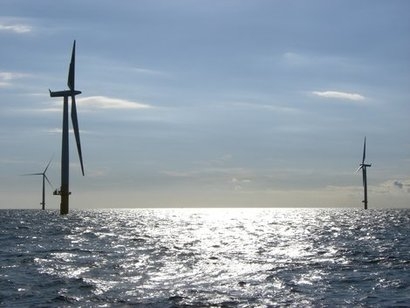
The seven wind projects each cost between $600 million and $4.5 billion. The latest authoritative figures from the Bloomberg New Energy Finance (BNEF) database of deals and projects show that the world invested $66.9 billion in clean energy in 3Q 2017, up from $64.9 billion in the second quarter of this year and $47.8 billion in the third quarter of 2016.
The numbers for the July-to-September quarter mean that investment in 2017 so far is running 2 percent above that in the same period of last year, suggesting that the annual total is likely to finish up close to, or a little ahead of, 2016’s figure of $287.5 billion. This year looks highly unlikely, however, to beat the record of $348.5 billion reached in 2015.
The stand-out move of the third quarter of 2017 was American Electric Power investing $4.5 billion in Invenergy’s 2 GW Wind Catcher project in the Oklahoma Panhandle. Due to be completed by 2020, the project will have 800 turbines, connected to population centres via a 350-mile high-voltage power line. AEP still needs to secure some regulatory approvals, but construction has started and BNEF is treating the project as financed.
“Wind Catcher is an example of a regulated utility in a wind-rich area of the US taking advantage of federal tax credits to build a project that will produce electricity at below the cost of its existing coal and gas generating plants” said Amy Grace, head of North America research for BNEF.
The other top asset finance transactions of the quarter were Dong Energy’s decision to proceed with the 1.4GW Hornsea 2 offshore wind farm in the UK North Sea, at an estimated $3.7 billion by the time it is completed in 2022-2023, and Northland Power’s financing of the 252 MW Deutsche Bucht array in German waters, at $1.6 billion.
After those came two Chinese offshore wind farms (Guohua Dongtai and Zhoushan Putuo) totaling 552 MW and an estimated $2.1 billion, the Zuma Reynosa III onshore wind farm in Mexico, at 424 MW and an estimated $657 million, and the 450 MW Coopers Gap onshore wind project in Queensland, Australia at $631 million. The biggest solar project financing was an estimated $460 million for First Solar’s 381 MW California Flats PV park in the US
Breaking the 3Q 2017 figures down by type of investment, asset finance of utility-scale renewable energy projects, such as those above, jumped 72 percent globally compared to the same quarter of last year, reaching $54.3 billion. Small-scale project investment (solar systems of less than 1 MW) came to $10.8 billion in the latest quarter, up 9 percent
The two other areas of investment that BNEF tracks quarterly are venture capital and private equity investment in specialist clean energy companies, and equity-raising on public markets by quoted companies in the sector. Both these areas had subdued activity in the third quarter.
VC/PE funding was only $662 million in 3Q, down 79 percent from a very strong equivalent period a year earlier. July to September 2017 was the weakest quarter for this type of investment since 2005. The only deal to break three-figure millions was a $109 million private equity expansion capital round for Indian solar project developer Clean Max Enviro Energy Solutions.
Public markets investment was also subdued, down 63 percent year-on-year at $1.4 billion, its lowest quarter since 1Q 2016. The biggest equity raisings were by Chinese company Beijing Shouhang Resources Saving, to fund activity in solar thermal generation (a $675 million private placement), and a $314 million initial public offering by Greencoat Renewables, a Dublin-based investment company targeting operating-stage wind projects in Ireland and the rest of the euro area.
Abraham Louw, associate, clean energy economics at BNEF, added that the weak third quarter figure for public markets investment came ironically despite a strong performance from clean energy stocks, with the NEX index for instance rising 7.5 percent between the end of June and the end of September, and now standing 22 percent up since the start of 2017.
Taking all the categories of investment (asset finance, small-scale projects, VC/PE, public markets, and an adjustment for re-invested equity) together, country-level results for the third quarter included:
China $23.8 billion, up 35 percent compared to 2Q 2016, down 8 percent from 2Q 2017.
The U.S. $14.8 billion, up 45 percent year-on-year, up 8 percent quarter-on-quarter.
Europe $11.6 billion, up 43 percent year-on-year, up 45 percent quarter-on-quarter.
Germany $2.4 billion, down 5 percent year-on-year, down 26 percent quarter-on-quarter.
Japan $2.2 billion, down 32 percent year-on-year, down 17 percent quarter-on-quarter.
India $1.1 billion, down 49 percent year-on-year, down 60 percent quarter-on-quarter.
Brazil $1.7 billion, up 32 percent year-on-year, down 4 percent quarter-on-quarter.
Mexico $2.8 billion, up from almost nothing a year earlier, up 84 percent quarter-on-quarter.
Australia $1.8 billion, up 388 percent year-on-year, down 10 percent quarter-on-quarter.
Turkey $796 million, up from almost nothing a year earlier, and up 312 percent on 2Q 2017.
France $631 million, up 109 percent year-on-year, down 21 percent quarter-on-quarter.
South Korea $593 million, up 143 percent year-on-year and up 85 percent on 2Q 2017.
Argentina $1.2 billion, up from almost nothing in 3Q 2016 and up 151 percent from 2Q 2017.
The U.K. $4.6 billion, up 57 percent year-on-year, up tenfold quarter-on-quarter.
Chile $1 billion, up 134 percent year-on-year, up 306 percent quarter-on-quarter.
The following chart shows the quarterly trend in clean energy investment by region:
Global new investment in clean energy by region, by quarter, $billion
Source: Bloomberg New Energy Finance. Note: In this chart, asset finance is adjusted for re-invested equity. Clean energy covers renewable energy excluding large hydro, plus energy smart technologies such as energy efficiency, demand response, energy storage and electric vehicles.
BNEF’s annual figures, published every January, include certain categories of investment that are not in the quarterly data – namely corporate and government R&D in clean energy and asset finance of smart meters and energy storage projects.
For additional information:

